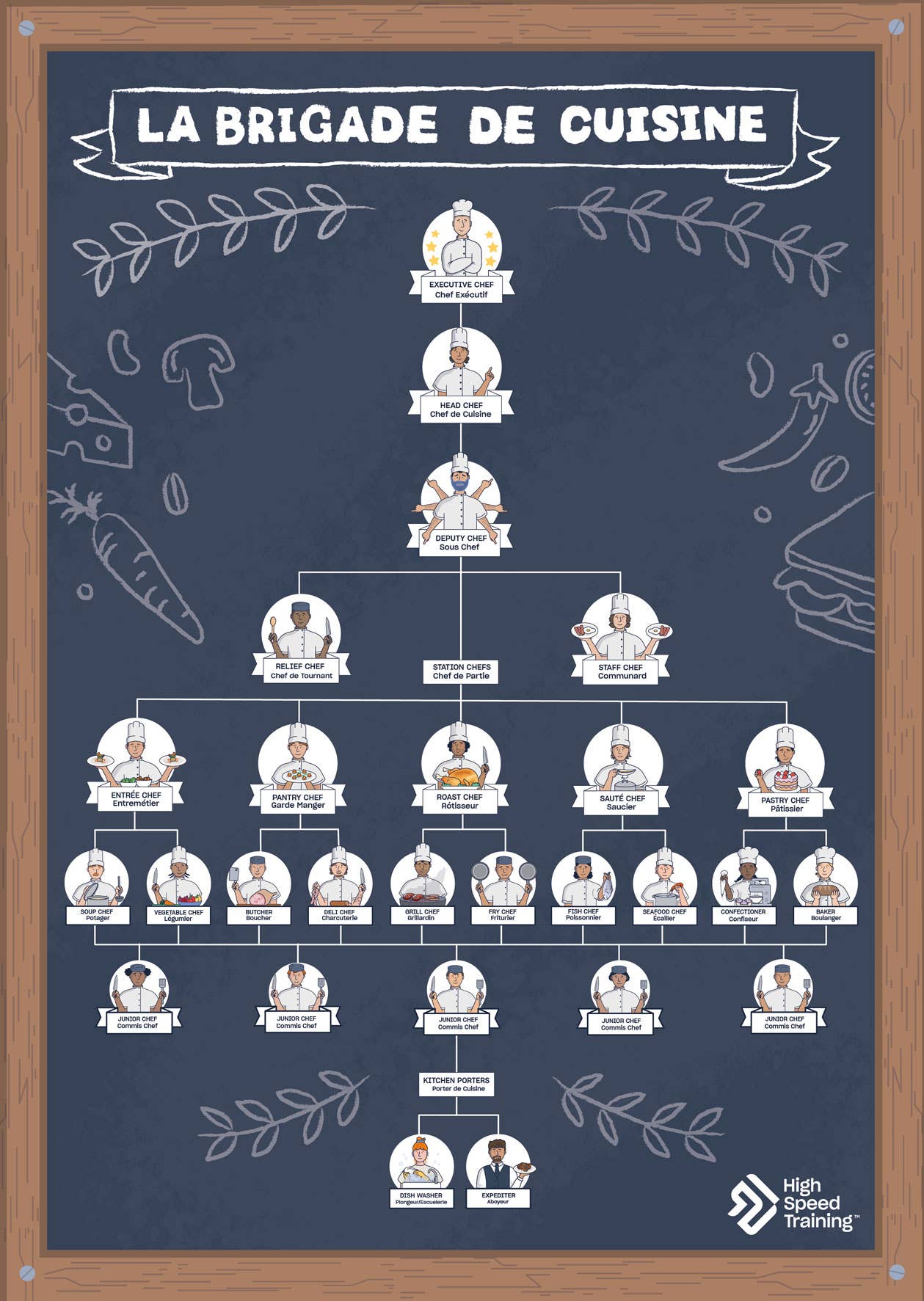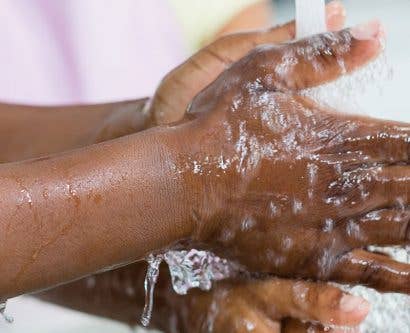The Kitchen Hierarchy Explained: What is the Brigade de Cuisine?
Most modern professional kitchens utilise the French kitchen hierarchy known as the Brigade de Cuisine. This system helps kitchens to run smoothly by establishing clear roles and delegating responsibilities to different individuals with different specialisms. If you work in hospitality it’s highly likely that you have heard of the Brigade de Cuisine or you may have heard commonly used Brigade de Cuisine terms such as sous chef or chef de partie.
The size and style of a restaurant will determine the size and structure of the Brigade de Cuisine used in the kitchen. That is to say, not every kitchen will have someone in each position and a small kitchen brigade is unlikely to have as many positions filled as a large kitchen brigade. Regardless of the size of your kitchen brigade, it’s important that you are aware of how the kitchen hierarchy is structured so that you have a clear understanding of how each position operates enabling your kitchen to run as smoothly as possible.
So, what exactly is the Brigade de Cuisine? Find out below and download our kitchen hierarchy chart.
What is the Kitchen Hierarchy?
The Brigade de Cuisine, also known as the kitchen hierarchy or kitchen brigade, is a hierarchical system used in professional kitchens. It is typically used in kitchens with an extensive number of staff, such as hotels or restaurants, but certain positions can and will be filled irrespective of the number of staff. The concept was developed by Auguste Escoffier who was celebrated as ‘the king of chefs and the chef of kings.’ Escoffier used his military background to develop the system and is heralded with establishing a level of kitchen organisation that was previously unheard of.

A full brigade can have upwards of 20 different positions, however only the largest of kitchens are likely to have a member of staff in each role. Below you will find details on the eight brigade positions that are typically found in most modern kitchens. It’s important to remember that whilst the word ‘chef’ is used internationally to mean a cook, it actually translates to ‘chief’ or ‘head.’
Executive Chef (Chef Exécutif)
The executive chef sits at the top of the kitchen hierarchy and their role is primarily managerial. Executive chefs tend to manage kitchens at multiple outlets and are not usually directly responsible for cooking.
Chef de Cuisine (Head Chef)
The head chef will typically focus on managerial duties relating to the whole kitchen. For example, they supervise and manage staff, control costs, make purchases and liaise with the restaurant manager and suppliers to create new menus.
Sous Chef (Deputy Chef)
The sous chef shares a lot of the same responsibilities as the head chef, however they are much more involved in the day-to-day operations in the kitchen. The sous chef also fills in for the head chef when they are not present.
Chef de Partie (Station Chef)
This role is a vital part of the brigade system and is split into many different roles. There is typically more than one chef de partie in a kitchen and each one is responsible for a different section of the kitchen. This makes kitchen operations much more productive and helps with the coordination of large quantities of food at busy times.
Specific chef de partie roles include:
- Sauté Chef/Saucier (Sauce Chef) – This chef is responsible for sautéing foods and creating sauces and gravies that accompany other dishes. They report directly to the head chef or sous chef.
- Boucher (Butcher Chef) – They prepare meat and poultry before they are delivered to their respective stations.
- Poissonnier (Fish Chef) – They prepare fish and seafood. In smaller kitchens, the boucher often takes on the role of the poisonnier.
- Rotisseur (Roast Chef) – They are responsible for roast meats and appropriate sauces.
- Friturier (Fry Chef) – This member of staff specialises in preparing fried food items.
- Grillardin (Grill Chef) – They are the king or queen of all things grilled.
- Garde Manger (Pantry Chef) – This person is in charge of the preparation of cold dishes, such as salads.
- Pattisier (Pastry Chef) – The master of all things pastry, baked goods and desserts.
- Chef de Tournant (Roundsman/Swing Cook/Relief Cook) – This person does not have a specific job, but rather fills in as and when needed at different stations.
- Entremetier (Vegetable Chef) – They prepare vegetables, soups, starches, and eggs. In larger kitchens, this role may split into two: Potager, who is in charge of making soups, and Legumier, who is in charge of preparing any vegetables.
Commis Chef (Junior Chef)
The commis chef works under the chef de partie to learn the ins and outs of a specific station. Junior chefs are typically partaking in formal training or have recently completed their formal training.
Kitchen Porter
Kitchen porters assist with basic tasks in the kitchen and are less likely to have had formal training. Their role typically involves introductory food preparation, such as peeling potatoes and some cleaning duties. Kitchen porters are sometimes also called prep cooks. Whilst some kitchens may separate these roles, there is a lot of overlap in their responsibilities and they both tend to assist with basic kitchen tasks such as food preparation and cleaning.
Escuelerie (Dishwasher)
This person is responsible for washing anything that was used in the food preparation and cooking process.
Aboyeur (Expediter)
This person is the link between the dining room and the kitchen. They relay orders and manage the flow of dishes. A common misconception is that aboyeur is another term for a waiter or waitress. However, the phrase literally translates to ‘barker’ and whilst they work closely with wait staff, their role is to ensure the kitchen is preparing food in the right order, that dishes are plated correctly and that customers are served promptly.
Kitchen Hierarchy Chart
As mentioned above, the kitchen brigade system comprises numerous different positions that may not all be filled in one kitchen. Below you will find a free downloadable chart that offers a visual representation of how the Brigade de Cuisine operates and the different roles that might be found in a kitchen. The chart shows the correlation between each role and gives you an idea of how the structure of the brigade can create a kitchen that runs efficiently.
It’s important to remember that whilst the Brigade de Cuisine establishes a hierarchy of operation, that is not to say that those lower down the hierarchy have unimportant roles. The power of the Brigade de Cuisine lies in the delegation of responsibilities and in order for a kitchen to run smoothly, every person, irrespective of their position on the chart, must consistently work to the best of their ability.
Kitchens both big and small utilise hierarchical structures to help them run efficiently. The Brigade de Cuisine is one of the most influential and well recognised of these hierarchical structures and it has been used in kitchens the world over to establish different roles and responsibilities. The Brigade de Cuisine establishes a delicate but effective ecosystem in which kitchens can thrive and individuals can enhance their specialisms whilst working as part of a larger, well oiled team.
Further Resources:
- Kitchen Safety Posters for Commercial Use
- How to Prepare for an EHO Inspection: Free Checklist
- Food Hygiene Courses












